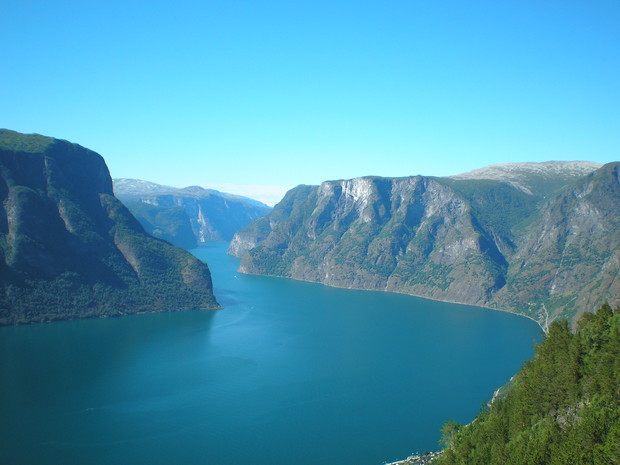 Norwegian mountains are not the tallest in the world, they just look like that. When you sit in the boat in the middle of the fjord you can see, how steeply they fall into the turquoise waters, while the waterfalls rush down the slope.
Norwegian mountains are not the tallest in the world, they just look like that. When you sit in the boat in the middle of the fjord you can see, how steeply they fall into the turquoise waters, while the waterfalls rush down the slope.
In the Norwegian kingdom of fjords you can experience majestic nature, idyllic and thrilling at the same time.
There is a reason "fjord" is one of the few Norwegian words, which have become international:Norway's long coastline is one area of the world, where the most fjords are located – almost 1200 the fjords got their own name. Some of them are also among the longest in the world, including Sognefjorden (204 km) in the Hardangerfjord (180 km).They are located in the western part of the country, between Stavanger in the south and Kristiansund in the north.
Two of the fjords in this part of the country have been designated UNESCO World Cultural and Natural Heritage Sites, 17 kilometer long Nseroyfjorden and 15 kilometer Geirangerfjorden.
They are famous for this, that they are the narrowest, the wildest and most spectacular fjords in the world, and they perfectly represent the thrilling landscape of the fjords, characteristic of this part of the country.
In the West Norwegian landscape of the fjords, besides many of Norway's highest mountains, there are eleven of 20 the country's largest glaciers. Jostedalsbreen with a surface 480 km2 is the largest glacier in continental Europe.
You can find traces of old settlements in many places in the Vestlandet region, including from the times of the Vikings. Norwegian stave churches are architectural monuments to the introduction of Christianity to Norway. Borgund stave churches and Urnes stave churches lie in the arms of the Sognefjorden fjord, and come from the 12th and 13th centuries.
The western kingdom of the fjords is linked by a network of ferry connections, bridges, tunnels and steep uphill roads. Will you travel by land, or water, you will witness the spectacle, whose very nature is the director. A trip along narrow and winding roads to steep mountains or a fjord cruise, they are breathtaking and a lifetime experience.
In summer, many fjords and lakes turn green due to the silt flowing from the glaciers – lake 0ldevatnet.
Folgefonna is Norway's third largest glacier and a great spot for glacier hiking.
When the season is right, you can admire the beautiful rose garden at the Baronia in Rosendal, Hardanger.
The impressive Voringsfossen waterfall in the Eidfjord, Hardanger, is one of Norway's most visited natural attractions. Water falls from heights up 182 meters.
Latefoss Waterfall in Odda is one of Norway's most visited natural attractions.
In the summer, Flam is a port heavily frequented by cruise lines.
Viewpoint from Stegastein to the Sognefjorden. The Flamsbanen route is one of the most spectacular railway sections in the world. The train needs 55 minutes to drive 20 km from Myrdal train station to Hardangervidda. First, the train goes to the border with trees at height 900 meters, and then descends to Flam over Aurlandsfjorden.
Narrow and long on 17 km Naeróyfjorden is a branch of the Sognefjorden and is on the UNESCO World Heritage List.
The Urnesstave Church above Lustrafjorden is the oldest surviving stave church from the first half of the 12th century. The church is on the UNESCO World Heritage List. Borgundstavkirke is situated in Laerdal, in Sognefjorden and is one of Norway's best-preserved stave churches from the Middle Ages. Most of Norway's stave churches were erected in the 1150 -1350. Today only they are left 28. The Urnesstavkirke has a richly decorated interior.
Briksdalsbreen is a branch of the Jostedalsbreen Glacier.
Alesund – After a huge fire in 1904 year, the city was rebuilt and built within a few years 350 buildings in a characteristic Art Nouveau style. Today the city boasts one of the most beautiful and visually refined centers in Norway.
Jar Gudbrandsjuvet received a new look in 2010 year, thanks to the innovative architecture related to the National Tourist Routes project.
Trollstigen is the most famous hiking trail in Norway. This at times has a narrow and steep road in total 11 180 ° turns.
From the top of Dalsnibba (1476 m n.p.m.) panorama stretches over the Geirangerfjorden.
The Zalotnik waterfalls lie along the Geirangerfjorden fjord, The Seven Sisters and the Bride's Veil.
Hurtigruten in the Geirangerfjorden, understandable deviation from the "most beautiful voyage in the world" north to Kirkenes.
Trollveggen w Romsdalen, which makes you dizzy with a vertical drop of up to 1700 meters.
Between Molda and Kristiansund, you can cross the spectacular Atlantic Road, that jumps from island to island, adjacent to the ocean.
Kviknes Hotell w Balestrand, built in the Swiss style, whose history goes back a year 1752. The list of prominent guests is long, and the most famous of them was the German Emperor Wilhelm II.
